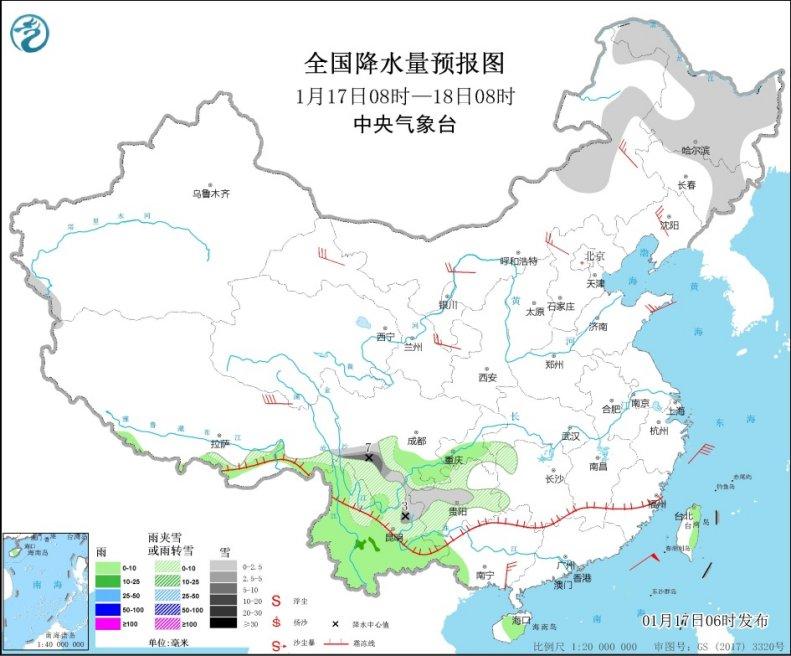China Weather News Today (January 17) the impact of the cold wave is coming to an end, and the Central Meteorological Observatory also lifted the cold wave warning this morning.
However, the temperature in most parts of the south is still in a low state, and the temperature in southern China and other places will drop, with precipitation mainly concentrated in the southwest and northeast regions.
Next week, most regions of the country will start the heating mode, and the temperature in many places will gradually turn to higher than normal.
Temperature drops in southern China
Yesterday, the cold wave mainly affected the southern region, and Jiangnan and other places suddenly felt the coldness of winter again from the previous warm state.
Live monitoring data show that at 05:00 today, compared with yesterday at 05:00, the central and eastern Qinghai-Tibet Plateau, Shaanxi, central and southern Shanxi, Guizhou, western Hunan and other places experienced a temperature drop of 6-10°C.
Today, the impact of this round of cold wave process has come to an end, and the temperature in most parts of the south remains low.
Like the east of the Southwest to the Jianghuai and Jiangnan areas, the highest temperature today is less than 10°C in most areas.
The temperature in southern China will also decline, with the highest temperature in many places less than 20°C and the lowest temperature in single digits.
Like Guangzhou, the highest temperature was around 23°C yesterday, but today it will drop to 17°C, and the body feels significantly colder.
The overall process of the cold wave seems to be "coming and going in a hurry." Starting today, the temperature in the north will gradually rise, and the temperature in most areas will be higher than normal.
Although there will be weak cold air affecting the Northeast again today and tomorrow, the temperature will gradually become higher than normal from next Wednesday, and the highest temperature in many parts of the south of the Northeast will rise to above 0℃.
The temperature in the south will also start a "rebound mode" starting next week. For example, Hangzhou, Changsha, and Nanchang will have a maximum temperature of only about 10°C this weekend, and the maximum temperature will rise to nearly 20°C again next Wednesday.
There is rain and snow in Heilongjiang, Guizhou and other places, and the development of meteorological drought in South China and Jiangnan
It is expected that today, rain and snow will mainly be concentrated in the southwest and northeast regions. Specifically, from 08:00 today to 08:00 tomorrow, the central and eastern Inner Mongolia, the northern and central parts of the Northeast, the southeastern Tibet, the southern Sichuan plateau, the northern Yunnan, There is light to moderate snow or sleet in parts of Guizhou, western Hunan and other places, and heavy snow in local areas.
There was light rain in parts of the central and southern Sichuan Basin, central and southern Yunnan, western Guangxi, and Hainan Island, and moderate rain locally.
The day after tomorrow, precipitation will weaken in most parts of the country, and fine weather will be the "protagonist" of the weather stage.
In southern China, southern Jiangnan and central and southern Yunnan, recent precipitation has been relatively low, and meteorological droughts have continued to develop. There have been severe droughts in some areas. For example, Shenzhen has not had effective precipitation since December.
Fortunately, there will be a round of precipitation in the south on the 20th, which may help alleviate the meteorological drought.
The Central Meteorological Observatory predicts that from the 20th to the 23rd, there will be moderate to heavy rains in parts of the eastern and southern parts of Southwest China, eastern Jianghan, Jiangnan, central and eastern South China, etc.; parts of the southeastern part of Northwestern China, western Jianghan and other places have successively light Moderate rain (snow) or sleet, heavy snow in high altitude areas.
Meteorological experts reminded that the recent temperature fluctuations have been large, the public should pay close attention to temperature changes, keep warm, and be alert to colds and other diseases that may be caused by temperature changes.
At the same time, in rain and snow, you must pay attention to traffic safety when traveling.

